Responsible for lawn maintenance, litter collection, snow removal, tree trimming and paved surface upkeep, the team ensures campus always looks its best and presents ample curb appeal for prospective students and faculty. Their work frequently creates the most sought-after locations for graduation photos of proud new alumni showing off their diplomas and academic regalia.
Dec. 20, 2022
Keeping campus green and white
Spartan Employee Spotlight – Landscape Services
Responsible for lawn maintenance, litter collection, snow removal, tree trimming and paved surface upkeep, the team ensures campus always looks its best and presents ample curb appeal for prospective students and faculty. Their work frequently creates the most sought-after locations for graduation photos of proud new alumni showing off their diplomas and academic regalia.
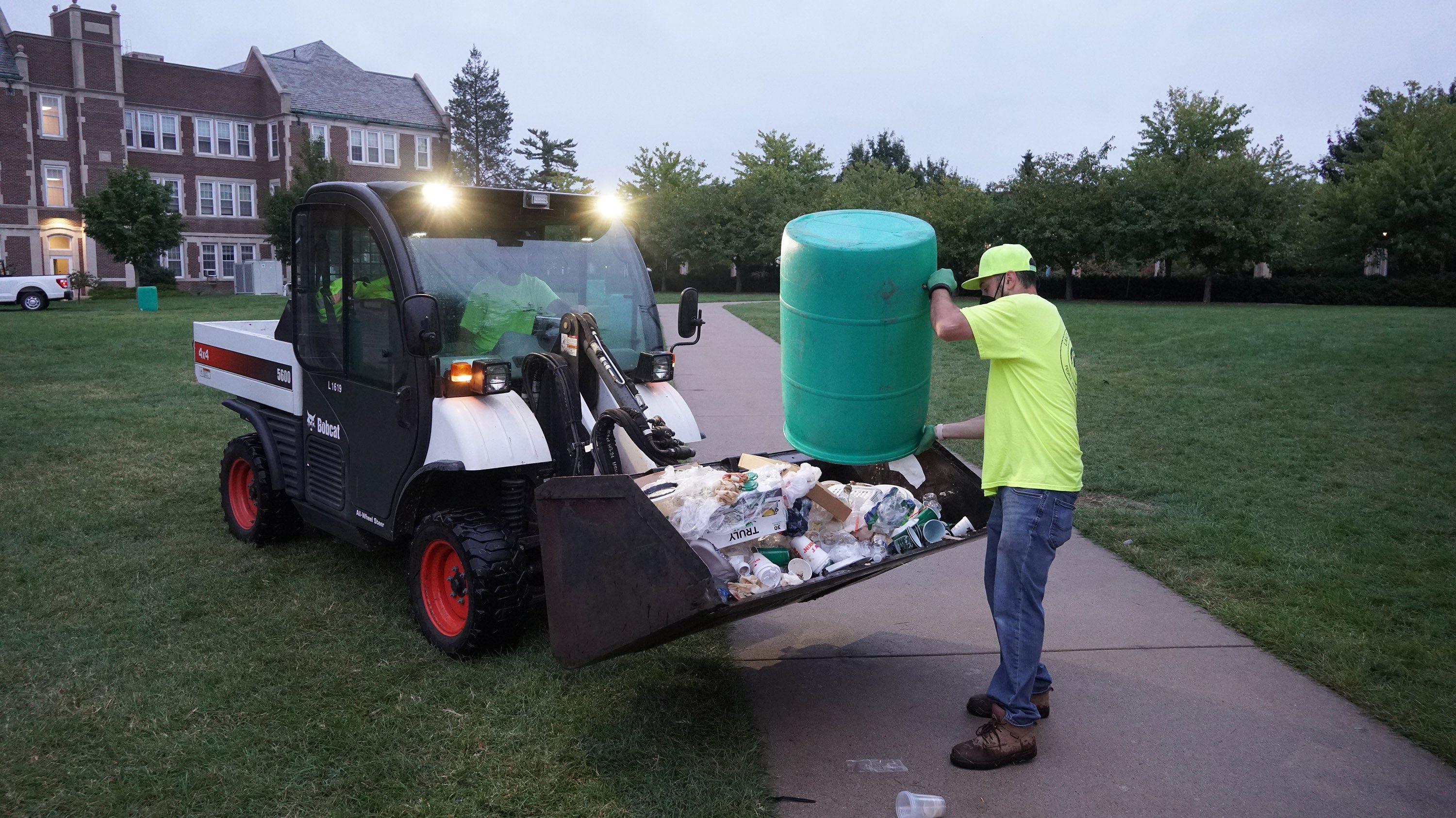
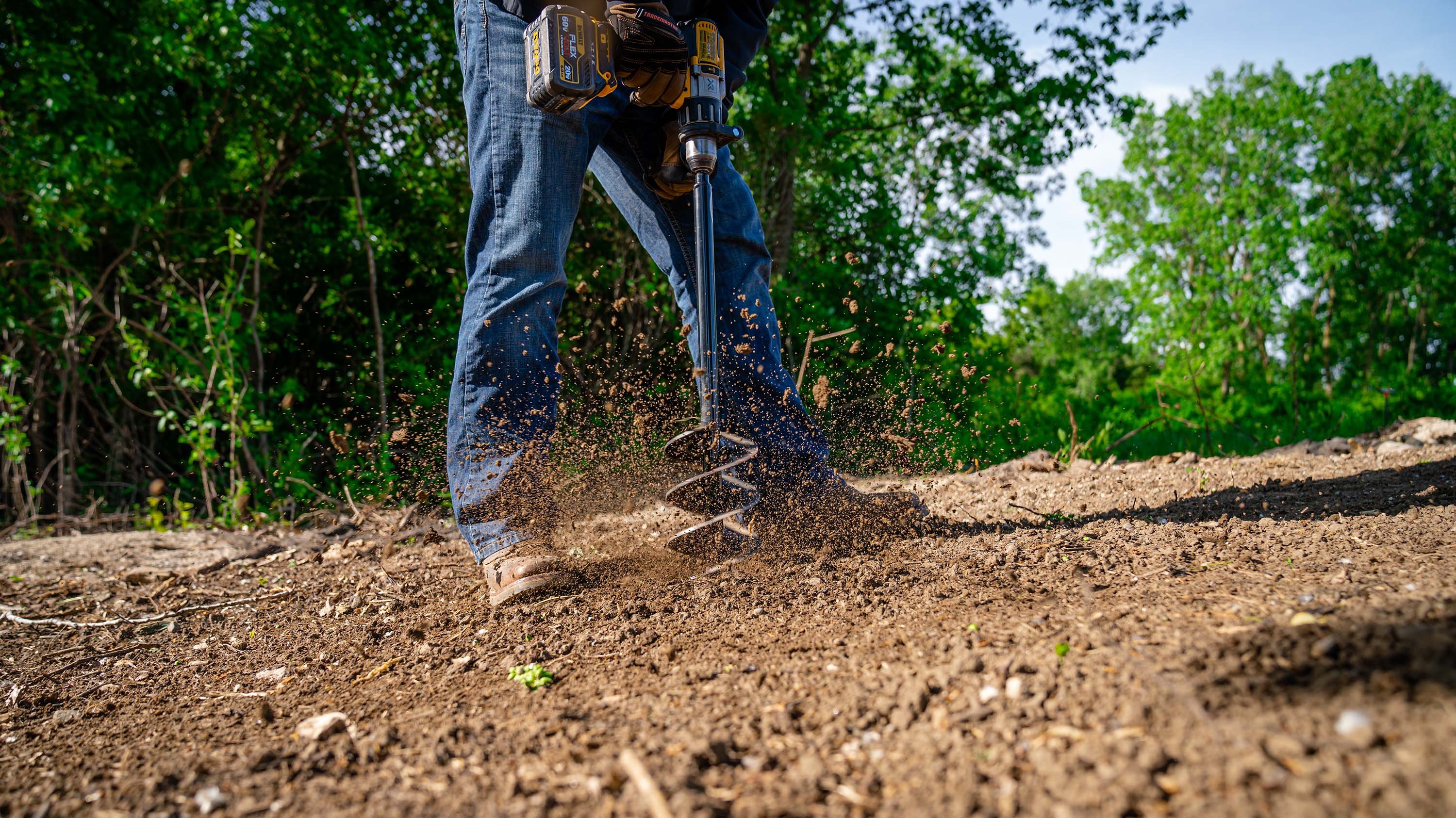
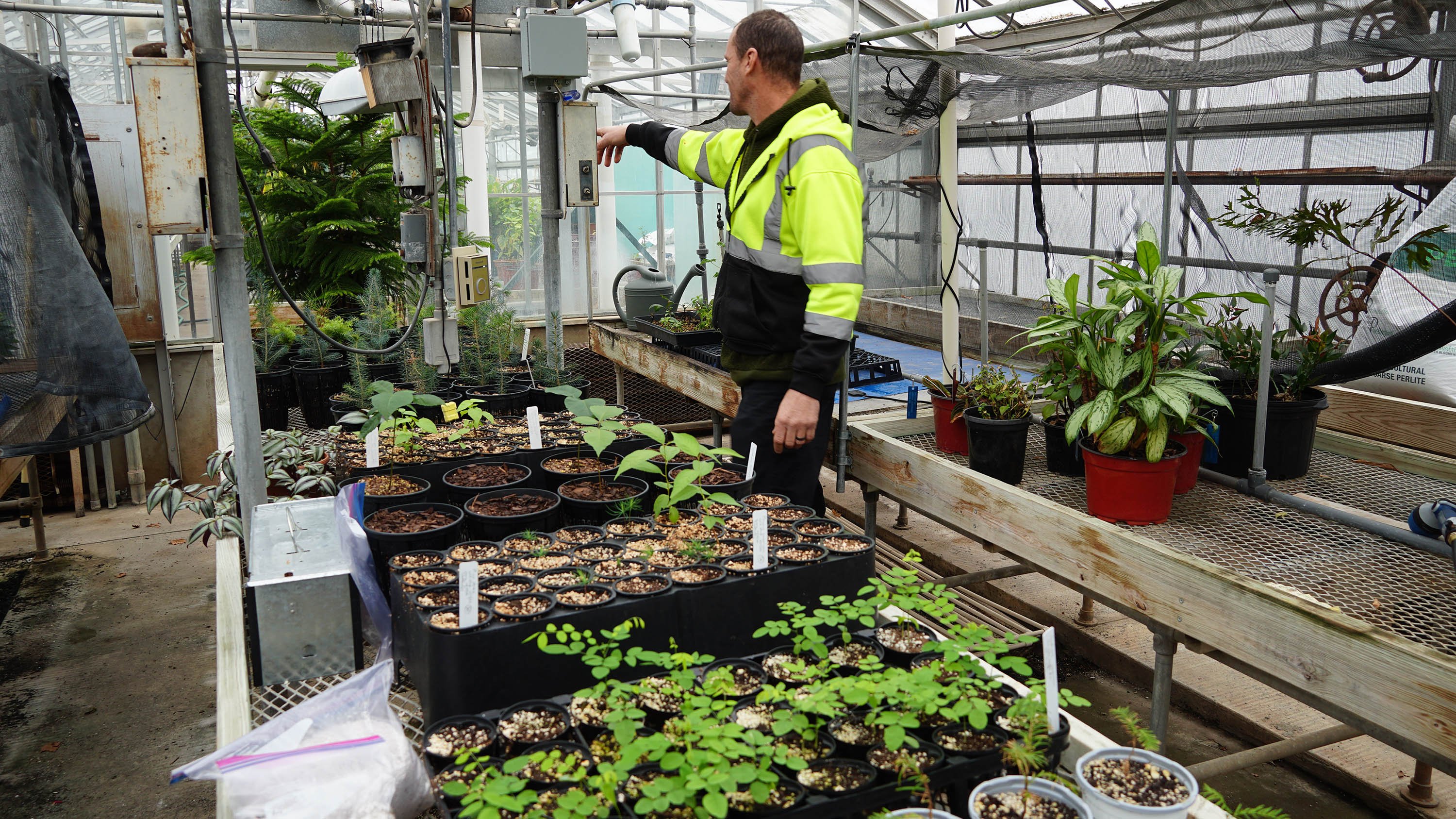
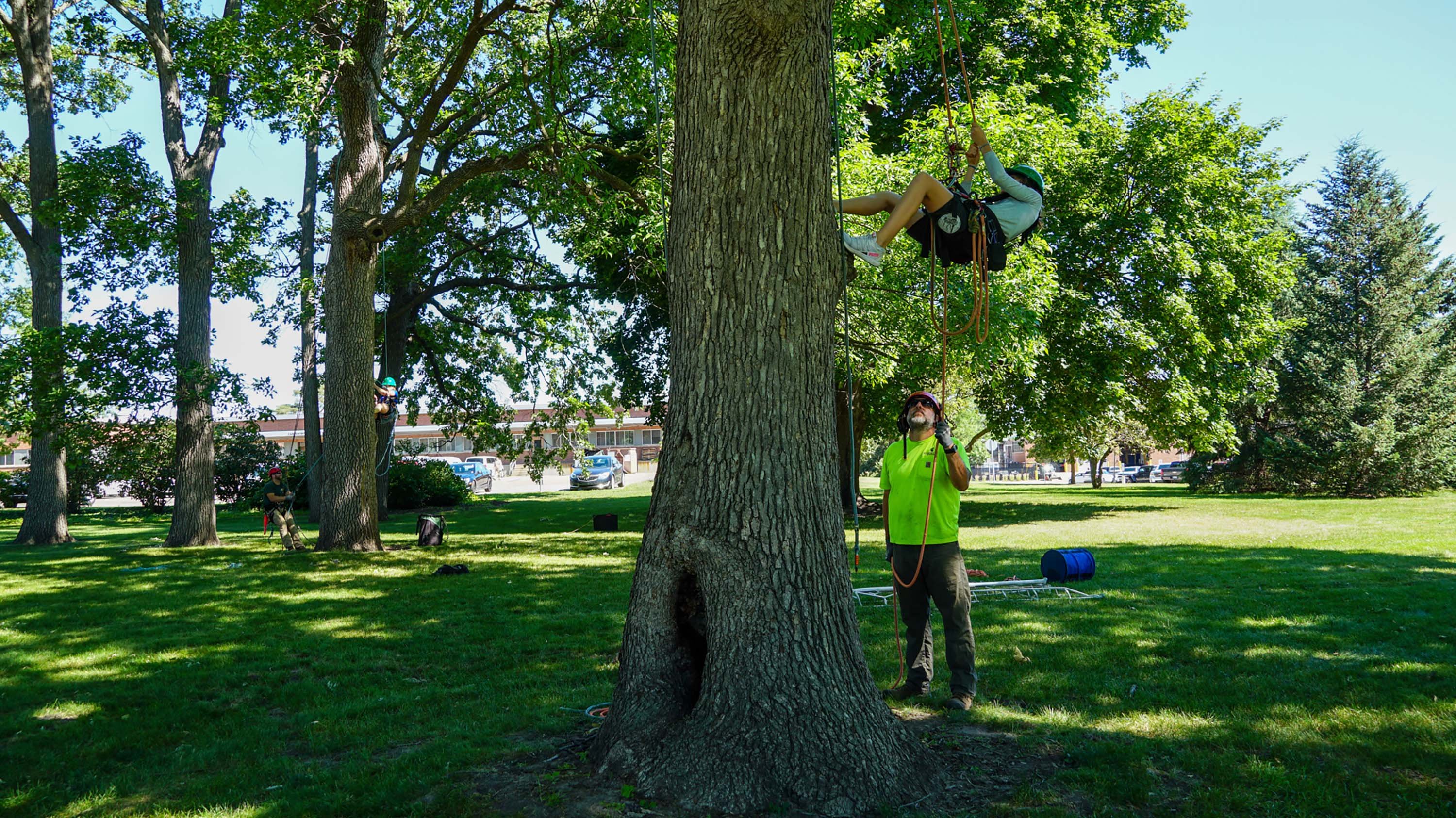

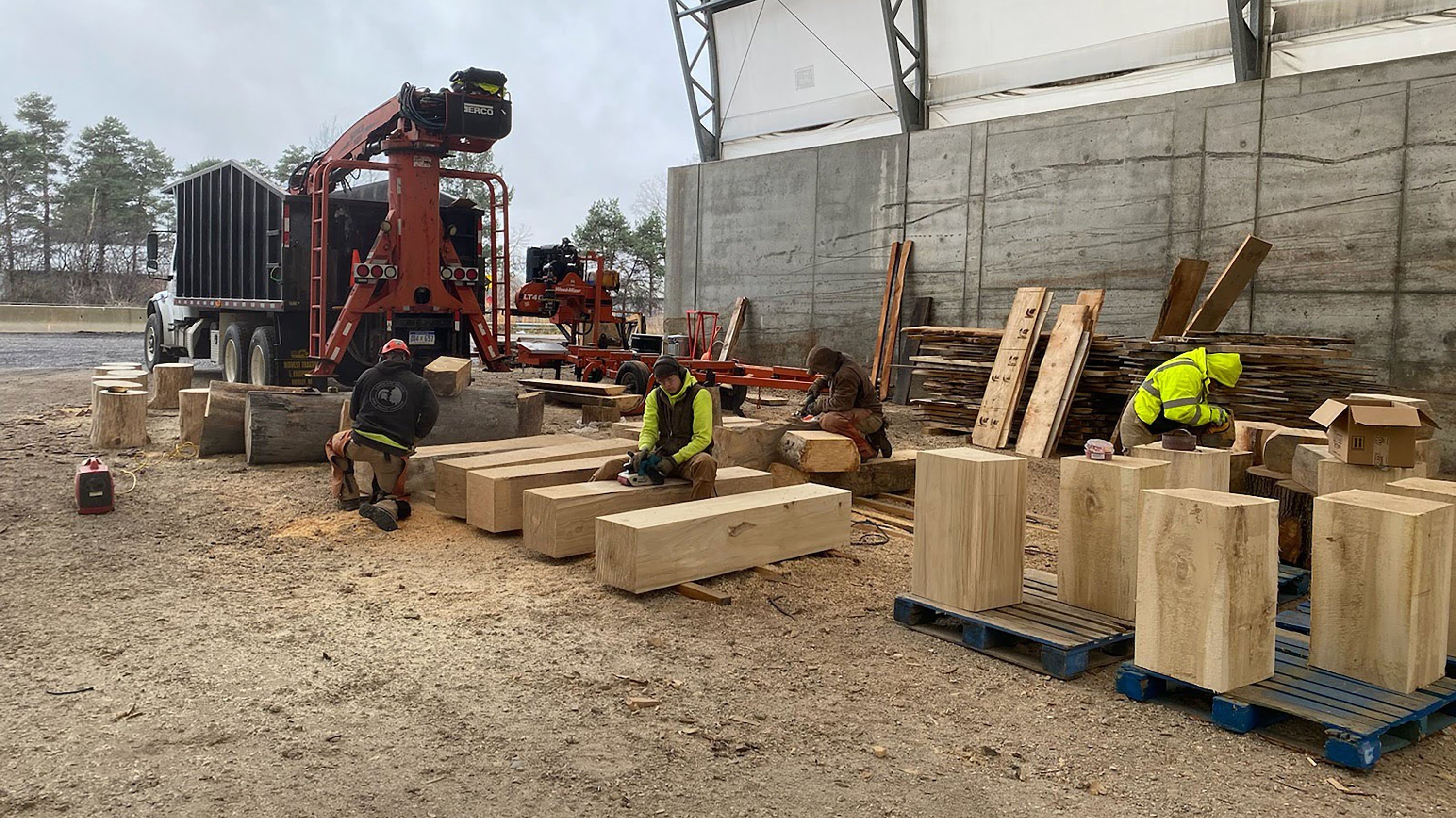
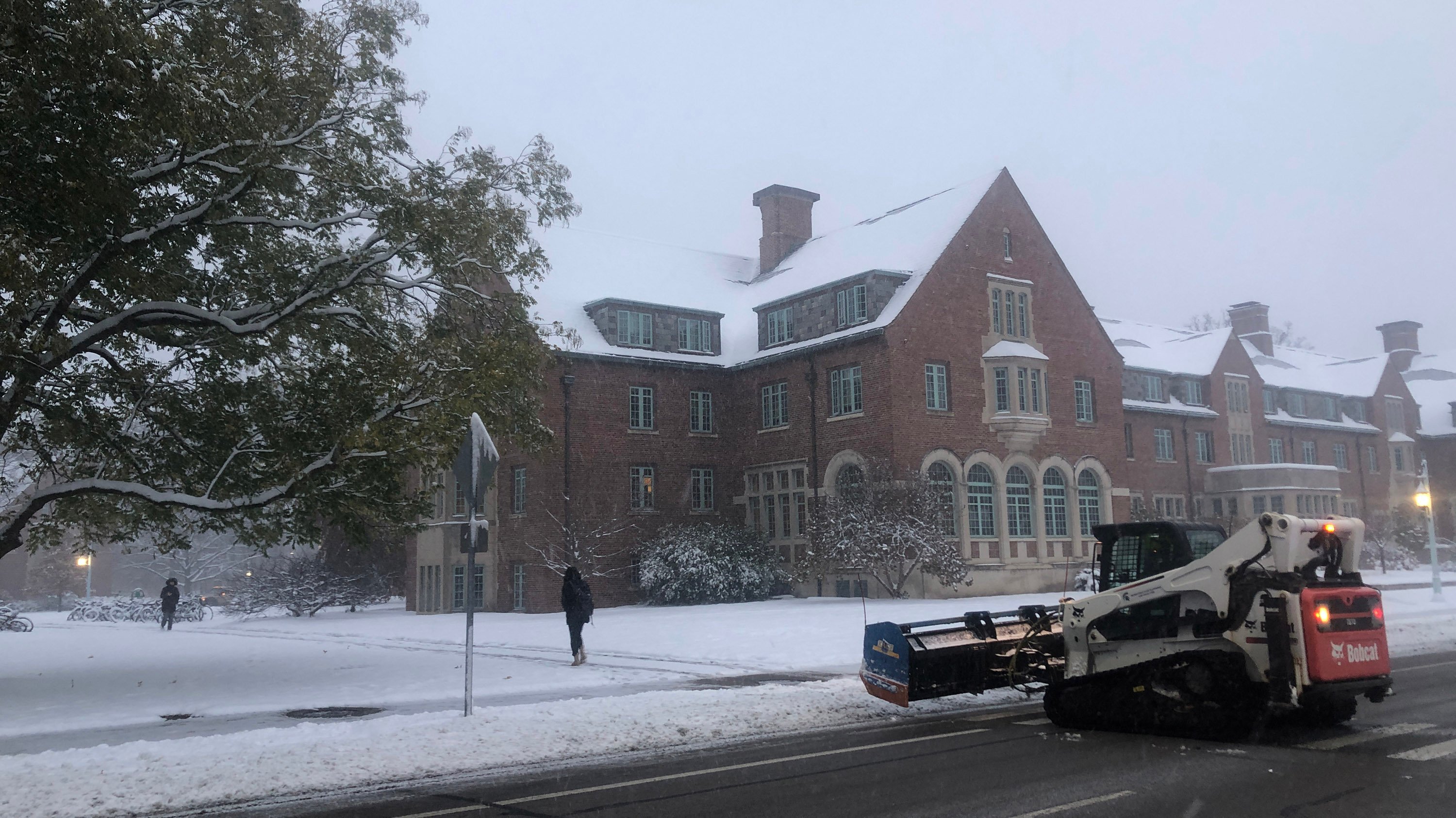
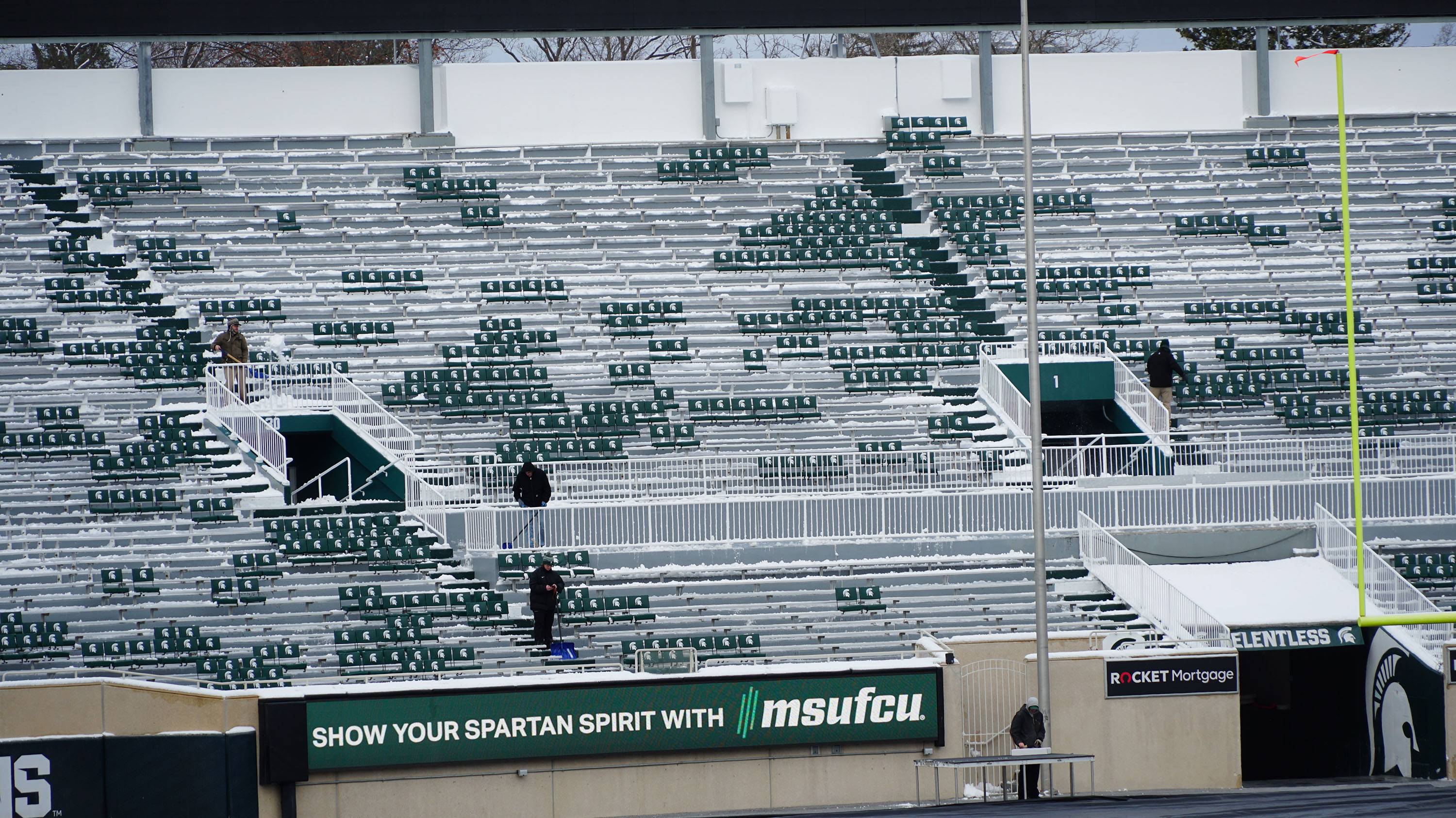
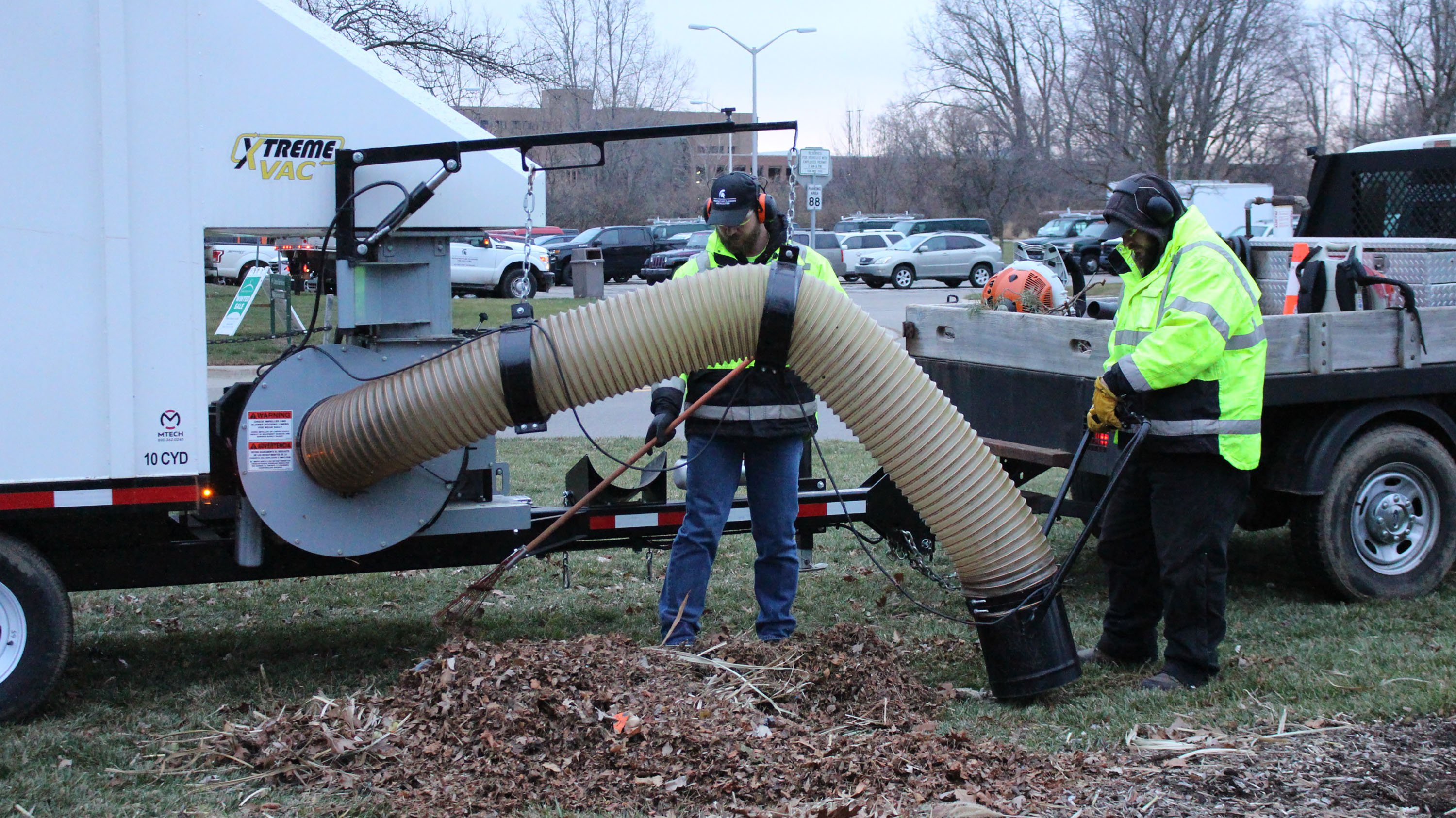










Piercefield, who has worked as a temporary laborer for six months with the Hard Surfaces crew, typically spends his workdays maintaining parking ramps by collecting trash and power washing surfaces. He said he came to MSU because of its reputation as a good local employer and the opportunity to join the team that maintains MSU’s park-like campus.
“I thought it’d be cool to be a part of that,” he said, adding that the best part of his job is the positive atmosphere his coworkers create every day.
Operations supervisor, Josh Ridner, bored holes in the soil as part of Project Wingspan, a three-year project through the Pollinator Partnership designed to increase the quality, quantity and connectivity of pollinator habitat across the Great Lakes region. Students in the College of Natural Science then planted native species in what was once an overgrown area on Trowbridge Road, transforming it into a pollinator garden full of plants that support bees, butterflies and other pollinators.
“We’re adding a lot of pollinator gardens on campus,” says Matthew Bailey, Landscape Services manager. “We installed a garden north of Shaw Hall with the Sustainable Spartans group, and we’re also restoring the banks of the Red Cedar River to create a pollinator corridor. This Project Wingspan grant is another step on our way toward a bee-friendly campus.”
Photo by Nick Schrader
“The Beaumont Nursery serves a lot of functions,” says Jerry Wahl, campus arborist. “As often as we can, we like to grow trees from the seeds of trees that were removed from campus, and this is where we grow them.”
The seeds are planted and grown in a greenhouse, then transferred to a pot once they’re big enough to survive outdoors. After a year or two, the trees are transferred to a field at the nursery where they continue to grow until they’re strong enough to be planted on campus.
The Beaumont Nursery also houses many plants from MSU’s Beal Botanical Garden that are not native to the area and can’t withstand the temperatures of a Michigan winter. This includes pineapple plants, chilis and many tropical plants that visitors can learn about and enjoy in the warmer months.
The event taught students how wood is milled, how to spot a girdling root and correct it, how to identify different types of trees on campus and more. By far the most popular activity, saved for the end of the workshop, gave students a chance to don an arborist harness and make their way up the trunk of a tree, just as MSU arborists do for trimming and pruning maintenance.
“Not only do we teach the kids about what an arborist does and how we keep trees healthy, we give them a chance to use some of the equipment we actually use in the field,” says Matthews. “By the end, they always want to climb all the way to the top.”
MSU is an urban arboretum — an outdoor living laboratory — with over 20,000 trees. Landscape Services is the steward of the university’s Campus Tree Management Plan, which was created to ensure the health of MSU’s trees and also maximize carbon sequestration, an important step to a greener campus.
Trees are removed from campus due to decline, storm damage or construction. Every tree that is removed from campus is replaced by a newly planted tree as part of a one-to-one replacement plan. Trees that are removed are repurposed into lumber via the MSU Shadows program. Items made from MSU’s lumber, like tables, chairs, benches and coasters, are sold in the Surplus Store and Recycling Center.
“The furniture can be used as an outdoor classroom or a small group meeting area,” says Yun Cao, a landscape architect with Landscape Services. “It’s also a place where students, faculty and staff can gather to just enjoy the outdoors.”
Last year IPF worked with the College of Education to install seating areas outside of Erickson Hall and recently worked with the College of Veterinary Medicine to create more modern-style pieces for its adjacent outdoor spaces.
Before the snow starts, workers apply a salt solution to walkways to slow snow accumulation and give themselves more time to start clearing snow and ice. The salt solution melts 1/4 inch of snow on contact and doesn’t allow it to adhere to pavement or sidewalks so IPF crews can clean it up easier and use less salt in the future. It requires four times less salt to prevent ice accumulation than to remove ice after it has formed. On average, IPF goes through about 3,000 gallons of the solution a day, focusing on high-traffic walkways, roadways and parking lots.
A November snowstorm filled Spartan Stadium prior to a home football game and needed to be cleared. Landscape crews grabbed shovels and leaf blowers and began clearing the stadium along with staff from Athletics, IPF Custodial Services and others. Utility vehicles with plows then worked to clear the concourse area.
Kauffman, a Laborer I, has worked at Landscape Services since March, helping with mowing and related duties on the main campus south of the river.
“I really enjoy being outside and in nature,” says Kauffman, adding he appreciates the opportunities for growth MSU provides personally and professionally. “I’ve felt the impact that the MSU community brings to the workplace.”
Piercefield, who has worked as a temporary laborer for six months with the Hard Surfaces crew, typically spends his workdays maintaining parking ramps by collecting trash and power washing surfaces. He said he came to MSU because of its reputation as a good local employer and the opportunity to join the team that maintains MSU’s park-like campus.
“I thought it’d be cool to be a part of that,” he said, adding that the best part of his job is the positive atmosphere his coworkers create every day.
Operations supervisor, Josh Ridner, bored holes in the soil as part of Project Wingspan, a three-year project through the Pollinator Partnership designed to increase the quality, quantity and connectivity of pollinator habitat across the Great Lakes region. Students in the College of Natural Science then planted native species in what was once an overgrown area on Trowbridge Road, transforming it into a pollinator garden full of plants that support bees, butterflies and other pollinators.
“We’re adding a lot of pollinator gardens on campus,” says Matthew Bailey, Landscape Services manager. “We installed a garden north of Shaw Hall with the Sustainable Spartans group, and we’re also restoring the banks of the Red Cedar River to create a pollinator corridor. This Project Wingspan grant is another step on our way toward a bee-friendly campus.”
Photo by Nick Schrader
“The Beaumont Nursery serves a lot of functions,” says Jerry Wahl, campus arborist. “As often as we can, we like to grow trees from the seeds of trees that were removed from campus, and this is where we grow them.”
The seeds are planted and grown in a greenhouse, then transferred to a pot once they’re big enough to survive outdoors. After a year or two, the trees are transferred to a field at the nursery where they continue to grow until they’re strong enough to be planted on campus.
The Beaumont Nursery also houses many plants from MSU’s Beal Botanical Garden that are not native to the area and can’t withstand the temperatures of a Michigan winter. This includes pineapple plants, chilis and many tropical plants that visitors can learn about and enjoy in the warmer months.
The event taught students how wood is milled, how to spot a girdling root and correct it, how to identify different types of trees on campus and more. By far the most popular activity, saved for the end of the workshop, gave students a chance to don an arborist harness and make their way up the trunk of a tree, just as MSU arborists do for trimming and pruning maintenance.
“Not only do we teach the kids about what an arborist does and how we keep trees healthy, we give them a chance to use some of the equipment we actually use in the field,” says Matthews. “By the end, they always want to climb all the way to the top.”
MSU is an urban arboretum — an outdoor living laboratory — with over 20,000 trees. Landscape Services is the steward of the university’s Campus Tree Management Plan, which was created to ensure the health of MSU’s trees and also maximize carbon sequestration, an important step to a greener campus.
Trees are removed from campus due to decline, storm damage or construction. Every tree that is removed from campus is replaced by a newly planted tree as part of a one-to-one replacement plan. Trees that are removed are repurposed into lumber via the MSU Shadows program. Items made from MSU’s lumber, like tables, chairs, benches and coasters, are sold in the Surplus Store and Recycling Center.
“The furniture can be used as an outdoor classroom or a small group meeting area,” says Yun Cao, a landscape architect with Landscape Services. “It’s also a place where students, faculty and staff can gather to just enjoy the outdoors.”
Last year IPF worked with the College of Education to install seating areas outside of Erickson Hall and recently worked with the College of Veterinary Medicine to create more modern-style pieces for its adjacent outdoor spaces.
Before the snow starts, workers apply a salt solution to walkways to slow snow accumulation and give themselves more time to start clearing snow and ice. The salt solution melts 1/4 inch of snow on contact and doesn’t allow it to adhere to pavement or sidewalks so IPF crews can clean it up easier and use less salt in the future. It requires four times less salt to prevent ice accumulation than to remove ice after it has formed. On average, IPF goes through about 3,000 gallons of the solution a day, focusing on high-traffic walkways, roadways and parking lots.
A November snowstorm filled Spartan Stadium prior to a home football game and needed to be cleared. Landscape crews grabbed shovels and leaf blowers and began clearing the stadium along with staff from Athletics, IPF Custodial Services and others. Utility vehicles with plows then worked to clear the concourse area.
Kauffman, a Laborer I, has worked at Landscape Services since March, helping with mowing and related duties on the main campus south of the river.
“I really enjoy being outside and in nature,” says Kauffman, adding he appreciates the opportunities for growth MSU provides personally and professionally. “I’ve felt the impact that the MSU community brings to the workplace.”
Piercefield, who has worked as a temporary laborer for six months with the Hard Surfaces crew, typically spends his workdays maintaining parking ramps by collecting trash and power washing surfaces. He said he came to MSU because of its reputation as a good local employer and the opportunity to join the team that maintains MSU’s park-like campus.
“I thought it’d be cool to be a part of that,” he said, adding that the best part of his job is the positive atmosphere his coworkers create every day.
01 / 09